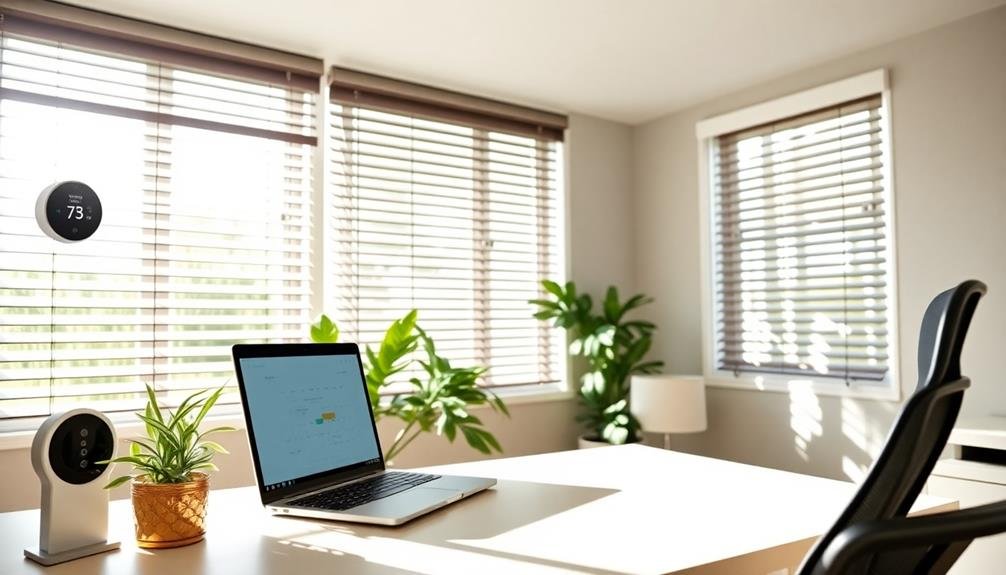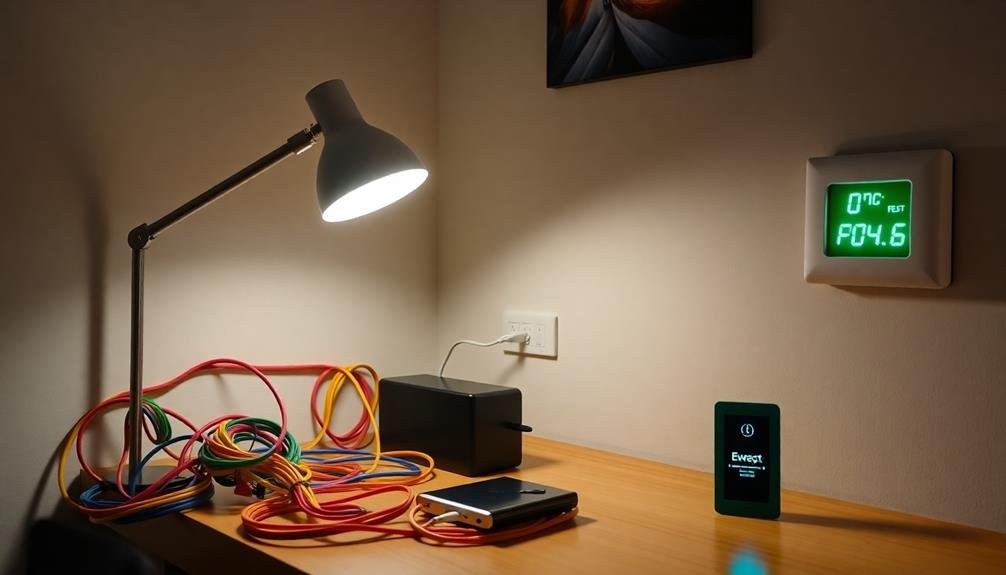To maximize energy efficiency in your doorbell automation setup, start by selecting a low-power doorbell model with energy-saving features like LED indicators and low standby power draw. Next, enhance your wireless connection settings by adjusting your Wi-Fi to 2.4GHz, reducing transmission power, and enabling sleep modes on both your doorbell and router. Finally, implement motion detection zones to limit monitored areas and reduce unnecessary power drain. Set up specific zones based on your property layout, exclude high-traffic areas, and adjust sensitivity settings to minimize false alerts. By following these tips, you'll considerably cut down on energy consumption while maintaining ideal performance. Discover more ways to fine-tune your doorbell's efficiency and save power in the long run.
Choose Low-Power Doorbell Models

When selecting a doorbell for automation, opt for models designed with energy efficiency in mind. Look for doorbells that use low-voltage wiring systems, typically operating on 16-24 volts. These systems consume less power than their high-voltage counterparts, reducing your overall energy usage.
Consider battery-powered wireless doorbells as they don't require constant power from your home's electrical system. Many modern wireless doorbells use long-lasting lithium-ion batteries that can operate for months or even years on a single charge. Some models also feature solar panels for recharging, further reducing power consumption.
Pay attention to the doorbell's standby power consumption. Choose models with low standby power draw, as they'll use minimal energy when not actively ringing. Look for doorbells with energy-saving modes or those that use motion sensors to activate only when someone approaches.
LED indicators are more energy-efficient than traditional bulbs. Opt for doorbells with LED lights for visual alerts. Additionally, select models with adjustable volume or the ability to turn off sound notifications, as this can help conserve power when you're home and don't need audible alerts.
Optimize Wireless Connection Settings
To cut down on power consumption, fine-tune your doorbell's wireless connection settings. Start by adjusting the Wi-Fi frequency to 2.4GHz instead of 5GHz, as it requires less power and offers better range. Reduce the transmission power to the lowest level that maintains a stable connection. This lessens energy usage while still ensuring reliable performance.
Enable power-saving modes on both your doorbell and router. Many smart doorbells have sleep modes that activate when idle, conserving battery life. Configure your router to use Wi-Fi power-saving features like beacon intervals and DTIM periods.
Here's a quick reference table for optimizing wireless settings:
| Setting | Action | Benefit |
|---|---|---|
| Frequency | Switch to 2.4GHz | Lower power, better range |
| Transmission power | Reduce to minimum | Decreased energy consumption |
| Sleep mode | Enable on doorbell | Conserves battery when idle |
| Beacon interval | Increase on router | Reduces Wi-Fi polling |
| DTIM period | Increase on router | Allows longer sleep periods |
Regularly update your doorbell's firmware to take advantage of power-saving improvements. Consider using a Wi-Fi extender if your doorbell is far from the router, as a stronger signal requires less power to maintain the connection.
Implement Motion Detection Zones

Implementing motion detection zones can greatly reduce your doorbell's power consumption. By limiting the area your doorbell monitors, you'll decrease false alerts and unnecessary recordings, which drain battery life.
To set up effective motion zones, consider your property's layout and identify key areas that require monitoring. Start by accessing your doorbell's app or settings menu to locate the motion zone feature. You'll typically see a grid or outline of your camera's field of view. Use this to draw or select specific areas where you want to detect movement. Focus on high-traffic areas like walkways, driveways, and the immediate vicinity of your door.
Here are some tips for optimizing your motion detection zones:
- Exclude areas with frequent movement, such as busy streets or neighboring properties
- Adjust sensitivity settings to avoid triggers from small animals or swaying plants
- Create multiple small zones instead of one large area for more precise detection
- Regularly review and refine your zones based on false alert patterns
Frequently Asked Questions
How Long Do Batteries Typically Last in Wireless Video Doorbells?
You'll typically get 3-6 months of battery life from wireless video doorbells. However, it can vary based on usage, settings, and environmental factors. Some models may last up to a year with ideal conditions and conservative use.
Can Solar Panels Be Used to Power Smart Doorbells?
Yes, you can use solar panels to power smart doorbells. They're an eco-friendly option that'll keep your doorbell charged without relying on batteries or wiring. You'll need to guarantee adequate sunlight exposure for peak performance.
Do Smart Doorbells Work During Power Outages?
Most smart doorbells won't work during power outages as they rely on your home's electricity. However, if you've installed a battery-powered model or have a backup battery, you'll still be able to use your doorbell's features.
Are There Energy-Efficient Alternatives to Video Doorbells?
Yes, you've got energy-efficient alternatives to video doorbells. Consider low-power motion sensors, traditional battery-operated doorbells, or wireless chimes. You can also opt for solar-powered doorbells or simple mechanical knockers that don't require any electricity at all.
How Does Weather Affect the Power Consumption of Outdoor Smart Doorbells?
Weather impacts your smart doorbell's power usage markedly. Cold temperatures drain batteries faster, while extreme heat can strain components. Rain and snow increase power needs for waterproofing features. Sunlight may help solar-powered models but can overheat others.
In Summary
You've learned three key ways to save power when installing automated doorbells. By selecting energy-efficient models, fine-tuning your wireless settings, and setting up strategic motion detection zones, you'll greatly reduce power consumption. Remember, these tips won't just lower your energy bills; they'll also extend your device's battery life and reduce maintenance needs. As you implement these strategies, you're not only making your home smarter but also more environmentally friendly. Keep experimenting to find the perfect balance between functionality and energy efficiency.





Leave a Reply